Abstract
In the 12-year period 1975 to 1987, feces from 336 infants were examined for botulinal neurotoxin and Clostridium botulinum. All the infants had illnesses which prompted their physicians to consider infant botulism in the diagnosis. Stool specimens from 113 of the infants yielded organisms that produced botulinal neurotoxins assumed to be responsible for the illness. The types of botulinal toxin in the confirmed cases were distributed as follows: 38 A, 69 B, 2 atypical B, 1 E, 1 F, 1 A + B, and 1 B + F. The type A and B toxins in a single infant were produced by two different strains of organism, and the type B and F toxins in another infant were produced by a single strain. The physiological characteristics of all the isolated toxigenic organisms except two were consistent with those of group I (proteolytic) C. botulinum. The toxigenic isolate from the infant with type E botulism was identified as C. butyricum, and that from the infant with type F botulism was identified as C. barati. Toxin of the same type as produced by the isolated organisms was identified in feces of 98 of 111 culture-positive infants. Botulinal toxin was identified in the serum of 9 of 67 culture-positive infants (8 of 22 infants with type A organisms; 1 of 43 infants with type B organisms; neither of 2 infants with A + B or atypical type B organisms). Botulinal toxin was not detected in feces (206 infants) or in serum (114 infants) of the culture-negative infants. The culture-positive infants had clinical features and a course of illness consistent with those of infant botulism. Most of the culture-negative infants probably had illnesses other than botulism, but specimens might have been obtained late in some infants' illnesses, when the organism had disappeared.
Full text
PDF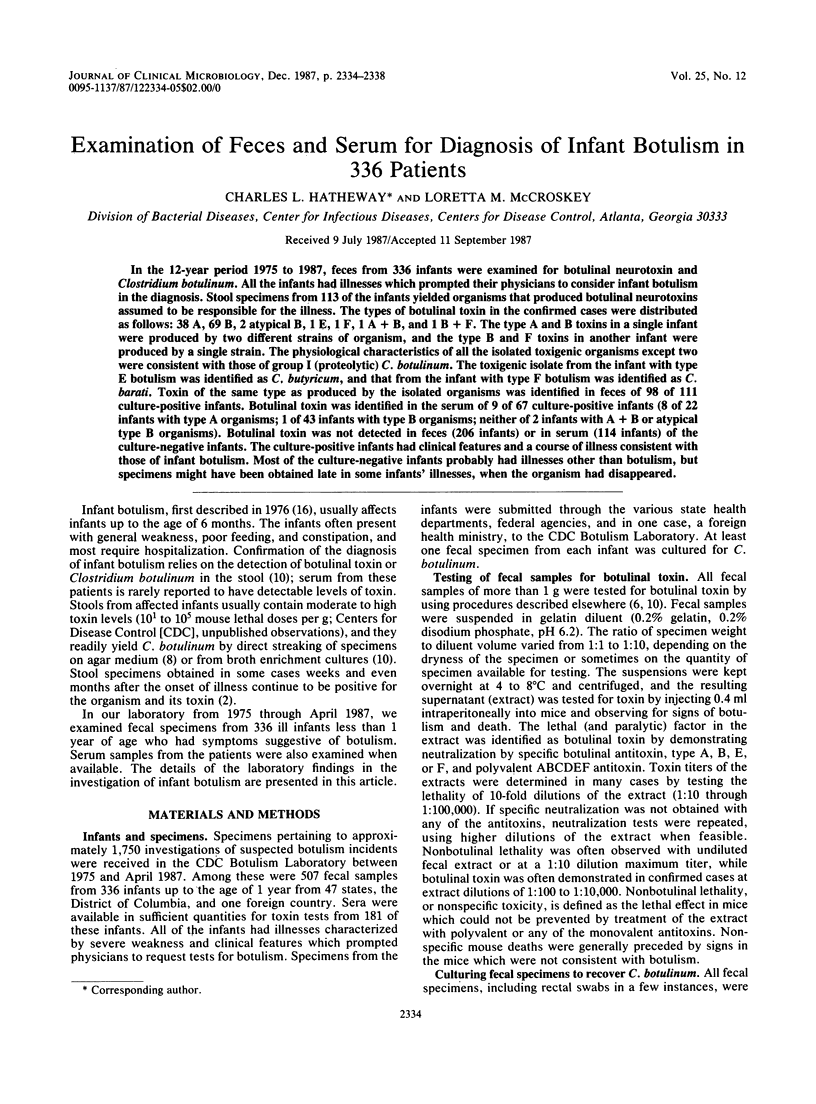
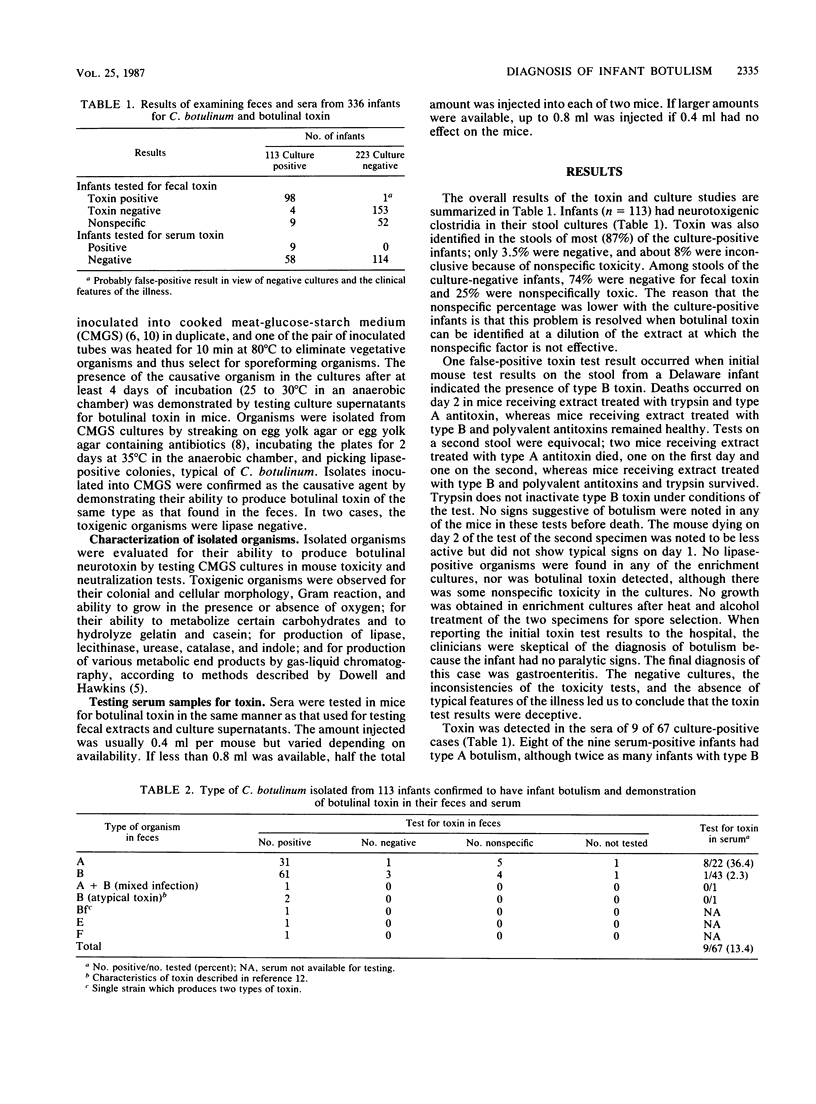
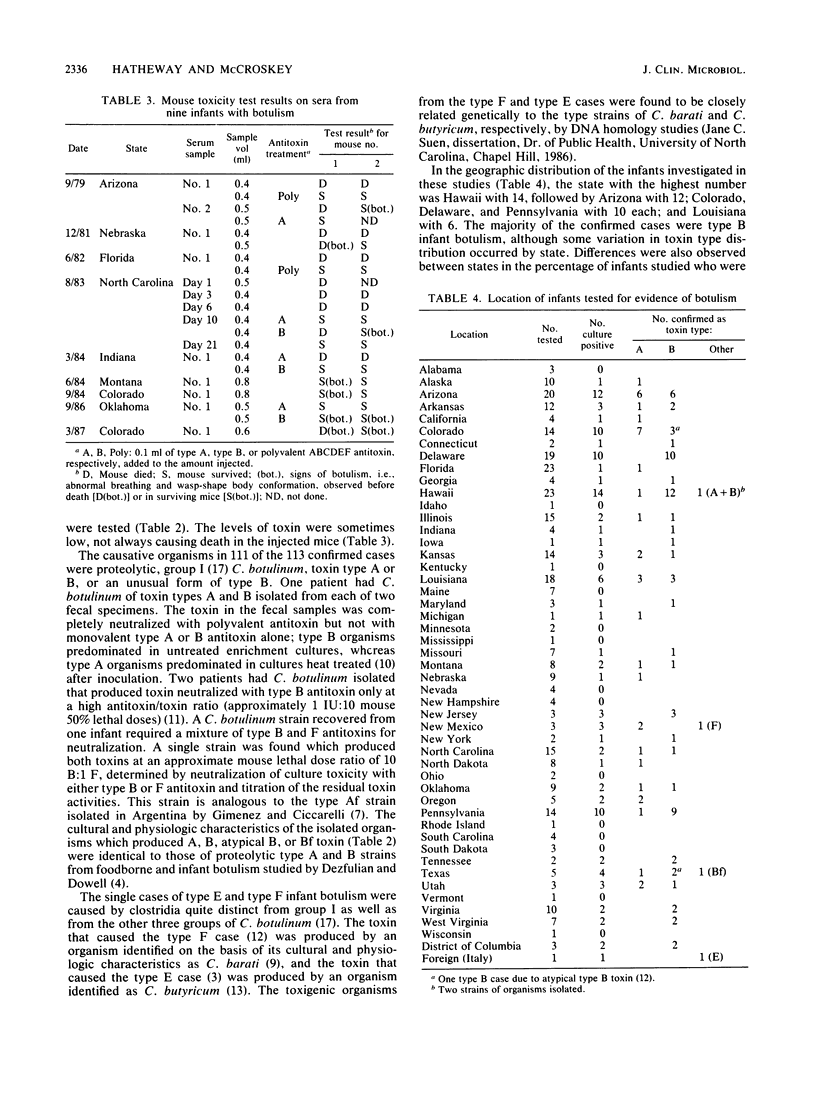
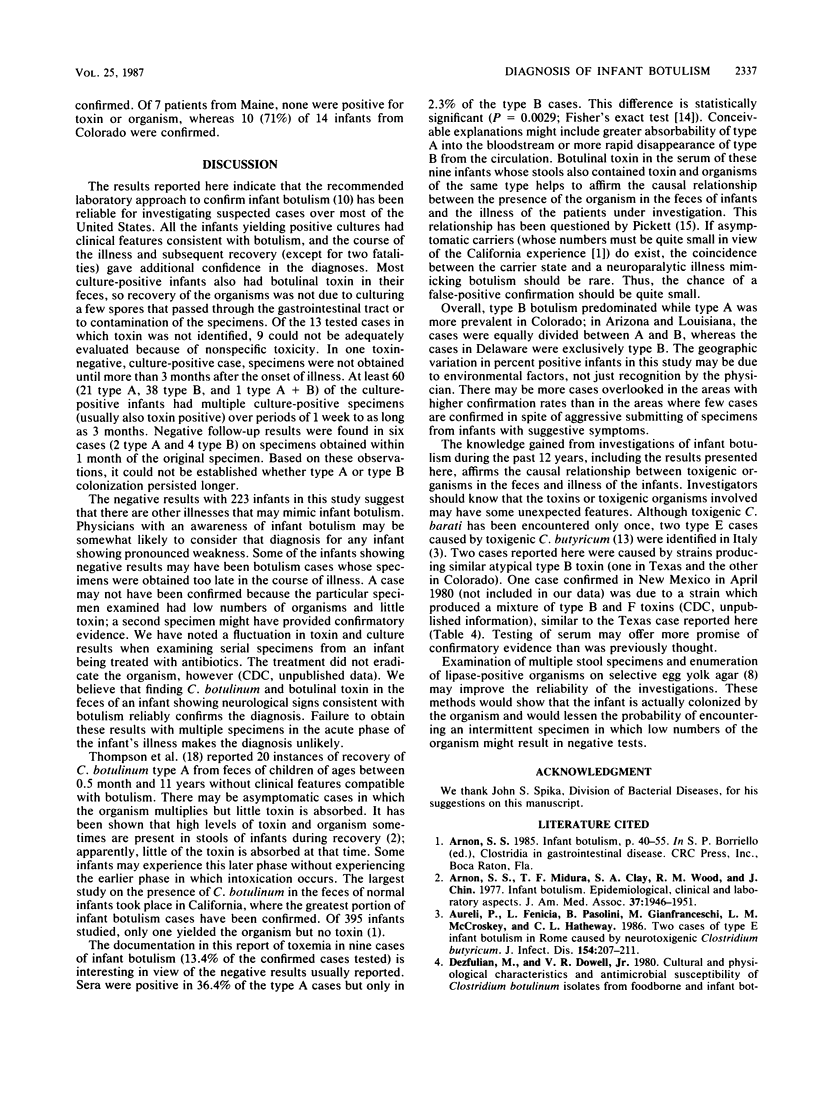
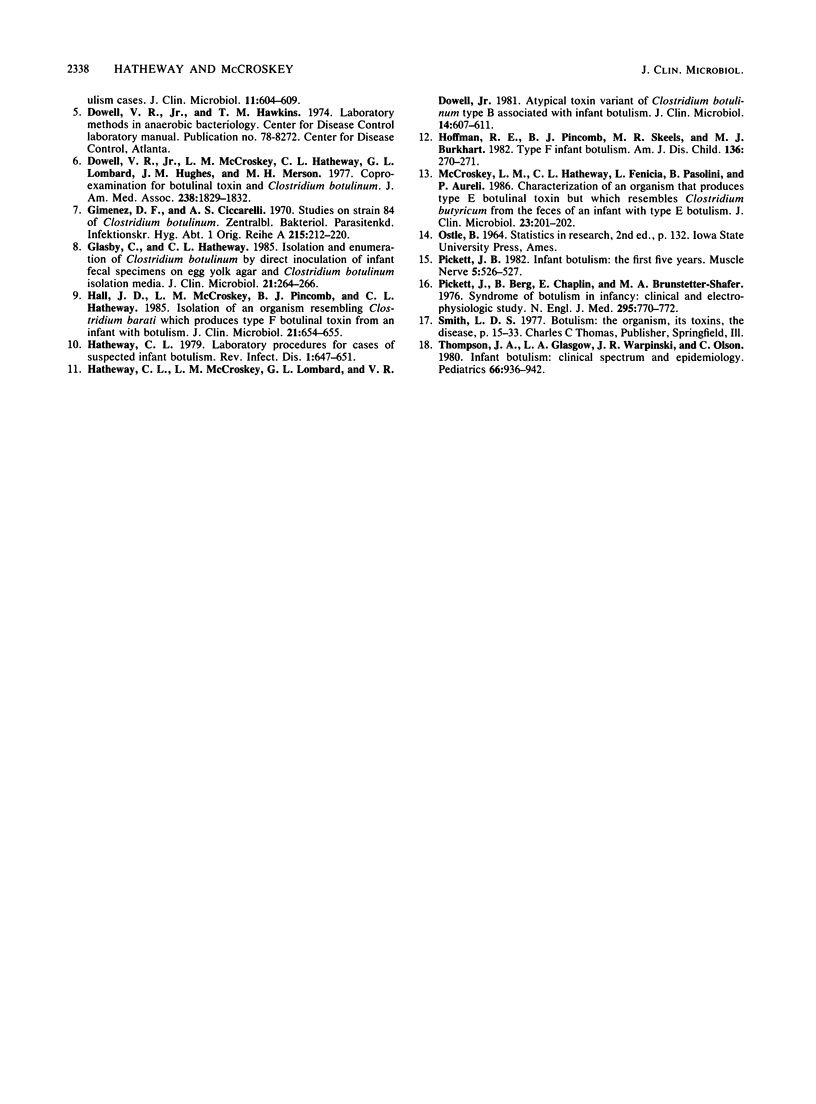
Selected References
These references are in PubMed. This may not be the complete list of references from this article.
- Arnon S. S., Midura T. F., Clay S. A., Wood R. M., Chin J. Infant botulism. Epidemiological, clinical, and laboratory aspects. JAMA. 1977 May 2;237(18):1946–1951. doi: 10.1001/jama.237.18.1946. [DOI] [PubMed] [Google Scholar]
- Aureli P., Fenicia L., Pasolini B., Gianfranceschi M., McCroskey L. M., Hatheway C. L. Two cases of type E infant botulism caused by neurotoxigenic Clostridium butyricum in Italy. J Infect Dis. 1986 Aug;154(2):207–211. doi: 10.1093/infdis/154.2.207. [DOI] [PubMed] [Google Scholar]
- Dezfulian M., Dowell V. R., Jr Cultural and physiological characteristics and antimicrobial susceptibility of Clostridium botulinum isolates from foodborne and infant botulism cases. J Clin Microbiol. 1980 Jun;11(6):604–609. doi: 10.1128/jcm.11.6.604-609.1980. [DOI] [PMC free article] [PubMed] [Google Scholar]
- Dowell V. R., Jr, McCroskey L. M., Hatheway C. L., Lombard G. L., Hughes J. M., Merson M. H. Coproexamination for botulinal toxin and clostridium botulinum. A new procedure for laboratory diagnosis of botulism. JAMA. 1977 Oct 24;238(17):1829–1832. [PubMed] [Google Scholar]
- Giménez D. F., Ciccarelli A. S. Studies on strain 84 of Clostridium botulinum. Zentralbl Bakteriol Orig. 1970;215(2):212–220. [PubMed] [Google Scholar]
- Glasby C., Hatheway C. L. Isolation and enumeration of Clostridium botulinum by direct inoculation of infant fecal specimens on egg yolk agar and Clostridium botulinum isolation media. J Clin Microbiol. 1985 Feb;21(2):264–266. doi: 10.1128/jcm.21.2.264-266.1985. [DOI] [PMC free article] [PubMed] [Google Scholar]
- Hall J. D., McCroskey L. M., Pincomb B. J., Hatheway C. L. Isolation of an organism resembling Clostridium barati which produces type F botulinal toxin from an infant with botulism. J Clin Microbiol. 1985 Apr;21(4):654–655. doi: 10.1128/jcm.21.4.654-655.1985. [DOI] [PMC free article] [PubMed] [Google Scholar]
- Hatheway C. L. Laboratory procedures for cases of suspected infant botulism. Rev Infect Dis. 1979 Jul-Aug;1(4):647–651. doi: 10.1093/clinids/1.4.647. [DOI] [PubMed] [Google Scholar]
- Hatheway C. L., McCroskey L. M., Lombard G. L., Dowell V. R., Jr Atypical toxin variant of Clostridium botulinum type B associated with infant botulism. J Clin Microbiol. 1981 Dec;14(6):607–611. doi: 10.1128/jcm.14.6.607-611.1981. [DOI] [PMC free article] [PubMed] [Google Scholar]
- Hoffman R. E., Pincomb B. J., Skeels M. R. Type F infant botulism. Am J Dis Child. 1982 Mar;136(3):270–271. doi: 10.1001/archpedi.1982.03970390084021. [DOI] [PubMed] [Google Scholar]
- McCroskey L. M., Hatheway C. L., Fenicia L., Pasolini B., Aureli P. Characterization of an organism that produces type E botulinal toxin but which resembles Clostridium butyricum from the feces of an infant with type E botulism. J Clin Microbiol. 1986 Jan;23(1):201–202. doi: 10.1128/jcm.23.1.201-202.1986. [DOI] [PMC free article] [PubMed] [Google Scholar]
- Pickett J., Berg B., Chaplin E., Brunstetter-Shafer M. A. Syndrome of botulism in infancy: clinical and electrophysiologic study. N Engl J Med. 1976 Sep 30;295(14):770–772. doi: 10.1056/NEJM197609302951407. [DOI] [PubMed] [Google Scholar]
- Thompson J. A., Glasgow L. A., Warpinski J. R., Olson C. Infant botulism: clinical spectrum and epidemiology. Pediatrics. 1980 Dec;66(6):936–942. [PubMed] [Google Scholar]


